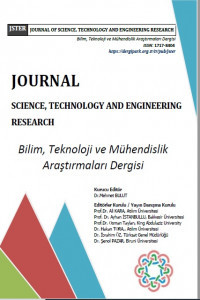Değişken Önemini Değerlendirmeye Dayalı Makine Öğrenme Algoritmalarının Karşılaştırmalı Analizi
Cubist, Random Forest, Makine Öğrenmesi, Mars, Değişken Önemi
Comparative Analysis of Machine Learning Algorithms Based on Variable Importance Evaluation
Cubist, Random Forest, Machine Learning, Mars, Variable Importance,
___
- [1] Ertoy, U. & Akçay, M. (2021). Covid-19 Virüsü Salgını İle Mücadelede Büyük Veri Çalışmaları: Çin Örneği . Journal of Scientific, Technology and Engineering Research , 2 (2) , 4-14 . DOI: 10.5281/zenodo.4718425.
- [2] Pazar, Ş. , Bulut, M. & Uysal, C. (2020). Yapay Zeka Tabanlı Araç Algılama Sistemi Geliştirilmesi . Journal of Scientific, Technology and Engineering Research , 1 (1) , 31-37 . DOI: 10.5281/zenodo.3922425
- [3] Li, J., Cheng, K., Wang, S., Morstatter, F., Trevino, R. P., Tang, J., & Liu, H. (2017). Feature selection: A data perspective. ACM Computing Surveys (CSUR), 50(6), 1-45. DOI: 10.1145/3136625.
- [4] Hall, M. A., & Smith, L. A. (1999, May). Feature selection for machine learning: comparing a correlation-based filter approach to the wrapper. In FLAIRS conference (Vol. 1999, pp. 235-239). DOI: 10.5555/646812.707499.
- [5] Guyon, I., & Elisseeff, A. (2003). An introduction to variable and feature selection. Journal of machine learning research, 3(Mar), 1157-1182. DOI: 10.5555/944919.944968.
- [6] Saeys, Y., Inza, I., & Larranaga, P. (2007). A review of feature selection techniques in bioinformatics. bioinformatics, 23(19), 2507-2517. DOI: 10.1093/bioinformatics/btm344.
- [7] Alelyani, S., Tang, J., & Liu, H. (2018). Feature selection for clustering: A review. Data Clustering, 29-60. DOI: 10.1201/9781315373515-2.
- [8] Chandrashekar, G., & Sahin, F. (2014). A survey on feature selection methods. Computers & Electrical Engineering, 40(1), 16-28. DOI: 10.1016/j.compeleceng.2013.11.024.
- [9] Tang, J., Alelyani, S., & Liu, H. (2014). Feature selection for classification: A review. Data classification: Algorithms and applications, 37. DOI: 10.1201/b17320.
- [10] El-Hasnony, I. M., Barakat, S. I., Elhoseny, M., & Mostafa, R. R. (2020). Improved feature selection model for big data analytics. IEEE Access, 8, 66989-67004. DOI: 10.1109/ACCESS.2020.2986232.
- [11] Karasu, S., Altan, A., Bekiros, S., & Ahmad, W. (2020). A new forecasting model with wrapper-based feature selection approach using multi-objective optimization technique for chaotic crude oil time series. Energy, 212, 118750. DOI: 10.1016/j.energy.2020.118750
- [12] Sharma, M., & Kaur, P. (2021). A Comprehensive Analysis of Nature-Inspired Meta-Heuristic Techniques for Feature Selection Problem. Archives of Computational Methods in Engineering, 28(3). DOI: 10.1007/s11831-020-09412-6.
- [13] Breiman, L. (2001). Random forests. Machine learning, 45(1), 5-32. DOI: 10.1023/A:1010933404324.
- [14] James, G., Witten, D., Hastie, T., & Tibshirani, R. (2021). Statistical learning. In An introduction to statistical learning (pp. 15-57). Springer, New York, NY. DOI: 10.1007/978-1-0716-1418-1_2.
- [15] Hastie, T., Hastie, T., Tibshirani, R., & Friedman, J. H. (2009). The elements of statistical learning: Data mining, inference, and prediction. New York: Springer. DOI: 10.1007/978-0-387-84858-7.
- [16] Friedman, J. H. (1991). Multivariate adaptive regression splines. The annals of statistics, 1-67. DOI: 10.1214/aos/1176347963.
- [17] Kuhn, M., & Johnson, K. (2013). Applied predictive modeling (Vol. 26, p. 13). New York: Springer. DOI: 10.1007/978-1-4614-6849-3.
- [18] Quinlan, J. R. (1987). Simplifying decision trees. International journal of man-machine studies, 27(3), 221-234. DOI: 10.1016/S0020-7373(87)80053-6.
- [19] Quinlan, J. R. (1992, November). Learning with continuous classes. In 5th Australian joint conference on artificial intelligence (Vol. 92, pp. 343-348). DOI: 10.1142/9789814536271
- [20] Quinlan, J. R. (1993, June). Combining instance-based and model-based learning. In Proceedings of the tenth international conference on machine learning (pp. 236-243). DOI: 10.5555/3091529.3091560.
- [21] Yıldırım, H. (2019). Property value assessment using artificial neural networks, hedonic regression and nearest neighbors regression methods. Selcuk University Journal of Engineering, Science and Technology, 7(2), 387-404. DOI: 10.15317/Scitech.2019.207.
- [22] Zingat. An online real estate website. https://www.zingat.com. (Last Access: March, 2018 ).
- [23] Kuhn, M. (2008). Building predictive models in R using the caret package. Journal of statistical software, 28(1), 1-26. DOI: 10.18637/jss.v028.i05.
- [24] Milborrow, S. (2019). earth: Multivariate Adaptive Regression Splines. R package version 5.1.1.
- [25] Kuhn, M., Weston, S., Keefer, C., Coulter, N., & Quinlan, R. (2014). Cubist: Rule-and instance-based regression modeling, R package version 0.0. 18.
- [26] Liaw, A., & Wiener, M. (2002). Classification and regression by randomForest. R news, 2(3), 18-22. DOI: 10.1021/ci034160g.
- Başlangıç: 2020
- Yayıncı: Mehmet BULUT
Windows Gömülü Bilgisayar üzerinde Petrol Sondaj Kulesi için Endüstriyel İletişim Güvenirliliği
Ongun YUCESAN, Altan ÖZKİL, Efe ÖZBEK
Covid-19 Virüsü Salgını İle Mücadelede Büyük Veri Çalışmaları: Çin Örneği
Öz yinelemeli sinirsel ağların sinirsel atım verilerinden yararlanılarak modellenmesi hakkında
Contemplation of the Photonics Beam to Complement the Water Cycle in Gulf Region
Imadeldin ELMUTASİM, Izzeldin I. MOHD, Khalid Hamid BİLAL
Berna VATANSEVER, Hakan AYDIN, Ali ÇETİNKAYA
Endüstriyel Robot Hareket Planlama Algoritmaları Performans Karşılaştırması
Dense Evrişimsel Ağ Kullanarak Kan Hücresi Görüntülerinden Kan Hücrelerinin Sınıflandırılması
Değişken Önemini Değerlendirmeye Dayalı Makine Öğrenme Algoritmalarının Karşılaştırmalı Analizi
